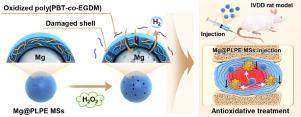椎间盘退变 (IVDD) 是一种以腰痛为特征的退行性疾病,可导致全球性残疾。考虑到活性氧 (ROS) 在 IVDD 发病机制中的关键作用,抗氧化疗法目前被认为是 IVDD 治疗最有希望的策略之一。在此,构建了一种对 ROS 敏感的含镁微球 (Mg@PLPE MS),用于 IVDD 的抗氧化处理。Mg@PLPE MS 具有核-壳结构,由聚(乳酸-共-乙醇酸)(PLGA)和 ROS 响应聚合物聚(PBT-共-EGDM)作为壳,以镁微粒为核。poly(PBT- co -EGDM) 可以通过 H 2 O被 H 2 O 2破坏2 -触发疏水到亲水转变,随后促进镁-水反应产生H 2。因此,Mg@PLPE MS 为消除 H 2 O 2和控制 H 2释放提供了一个有价值的平台。生成的 H 2通过与有害的 •OH 反应清除 ROS。值得注意的是,Mg@PLPE MS 在椎间盘退变大鼠模型中发挥了显着的抗氧化和抗炎作用,并减轻了细胞外基质降解和椎间盘细胞凋亡,从而强调了其在 IVDD 治疗中的功效。Mg@PLPE MS 还表现出强大的生物相容性和可忽略的毒性,为体内IVDD 的抗氧化治疗提供了希望。
重要性声明
鉴于活性氧 (ROS) 在 IVDD 发病机制中的关键作用,抗氧化疗法目前被认为是治疗椎间盘退变 (IVDD) 最有希望的策略之一。在这里,构建了对 ROS 敏感的含镁微球 (Mg@PLPE MSs),以通过控制释放氢气来减轻 IVDD。Mg@PLPE MSs 可以通过同时与 H 2 O 2反应有效清除过量产生的 ROS•OH,从而为抑制ECM降解创造了合适的微环境。结果,Mg@PLPE MSs 处理的 IVDD 大鼠表现出最小的髓核减少、更少的细胞外基质降解、最小的纤维环径向裂隙和更高的椎间盘高度指数。因此,所制备的 Mg@PLPE MSs 可能为 IVDD 的临床治疗提供新的思路。
 "点击查看英文标题和摘要"
"点击查看英文标题和摘要"
ROS-responsive magnesium-containing microspheres for antioxidative treatment of intervertebral disc degeneration
Intervertebral disc degeneration (IVDD) is a degenerative disease characterized by lower-back pain, causing disability globally. Antioxidant therapy is currently considered one of the most promising strategies for IVDD treatment, given the crucial role of reactive oxygen species (ROS) in IVDD pathogenesis. Herein, a ROS-responsive magnesium-containing microsphere (Mg@PLPE MS) was constructed for the antioxidative treatment of IVDD. The Mg@PLPE MS has a core-shell structure comprising poly(lactic-co-glycolic acid) (PLGA) and ROS-responsive polymer poly(PBT-co-EGDM) as the shell and a magnesium microparticle as the core. The poly(PBT-co-EGDM) can be destroyed by H2O2 through the H2O2-triggered hydrophobic-to-hydrophilic transition, subsequently promoting an Mg-water reaction to produce H2. Thus, Mg@PLPE MS provides a valuable platform for H2O2 elimination and controlled H2 release. The generated H2 scavenge for ROS by reacting with noxious •OH. Notably, the Mg@PLPE MS exerted significant antioxidative and anti-inflammatory effects in a disc degeneration rat model and alleviated extracellular matrix degradation and disc cells apoptosis, thereby underlining its efficacy in IVDD treatment. The Mg@PLPE MS also exhibited robust biocompatibility and negligible toxicity, presenting the promise for the antioxidative treatment of IVDD in vivo.
Statement of significance
Antioxidant therapy is currently considered one of the most promising strategies for intervertebral disc degeneration (IVDD) treatment, given the crucial role of reactive oxygen species (ROS) in IVDD pathogenesis. Here, ROS-responsive magnesium-containing microspheres (Mg@PLPE MSs) were constructed to alleviate IVDD through controlled release of hydrogen gas. The Mg@PLPE MSs can effectively scavenge overproduced ROS by simultaneously reacting with H2O2 and •OH, thus creating a suitable microenvironment for inhibition of ECM degradation. As a result, Mg@PLPE MSs treated IVDD rats exhibit minimal nucleus pulposus decrease, less extracellular matrix degradation, minimal radial fissure of fibrous rings, and higher disc height index. Therefore, the as-prepared Mg@PLPE MSs may shed a new light on clinical treatment of IVDD.




















































 京公网安备 11010802027423号
京公网安备 11010802027423号